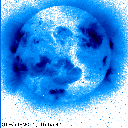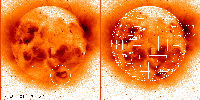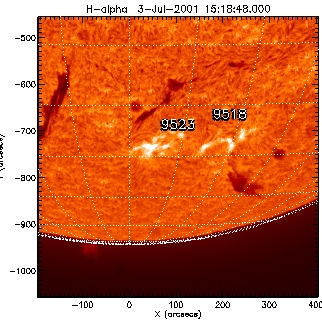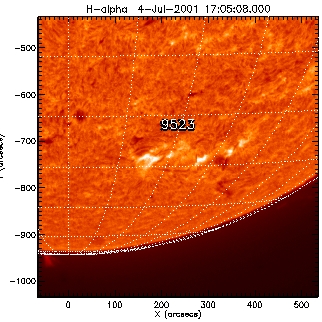
That's not to say that nothing at all happened worth noting on the earth-side surface. We were treated to a very extensive coronal hole, as you can see from the image below, taken July 1.

Additionally, the image reveals to you the topic of this week's Nugget, active regions at much-higher-than-average latitudes. Deep in the southern hemisphere is a pair of active regions at latitude South 49 degrees, and we shall focus on them this week. Their official designations are AR 9518 and AR 9523; images and other parameters are as follows.

| Date | Number | Location | Long | Area | Z | LL | NN | MagType |
|---|---|---|---|---|---|---|---|---|
| 3-JUL-01 | 9518 | S48W12 | 334 | 10 | BXO | 3 | 4 | BETAA |
| 3-JUL-01 | 9523 | S50W02 | 324 | 50 | DSO | 8 | 6 | BETAA |
For closer views, please visit here, the brand-new site providing a nice assembly of images of particular regions.
Attentive readers will recall a previous Nugget about
another high-latitude region (AR 9127, located at about 38 degrees in the
southern hemisphere), and may even remember that the Nugget tried to find
if the region in question was a "record breaker". An excerpt:
"The region kept growing in area, right through its limb passage. The mean area during its life through August 19 was 78 millionths, making it possibly the largest-and-most-southerly active region thus far this cycle, at least."
This month's entry is a bit further south still, and in fact is nearly the same size: the maximum sunspot area of the older AR 9127 was 160 millionths of a solar hemisphere, and so far the maximum of the bigger of the new regions, AR 9523, has been 130 millionths. The average spot area (averaged over the whole length of the active region's duration) is 78 millionths for both regions. And adding in AR 9518 (if that's not cheating) makes the sunspot area even larger. So there's a new contender for "largest-and-most-southerly active region thus far this cycle"!
What would an active region be without activity? On the 4th of July, while most American citizens were having a good time on the holiday of Independence Day, there occurred a few nice-looking CMEs, as shown in the movie captured by the LASCO C2 coronagraph on SoHO. In that movie, one can see three significant events observed at about 13:00 and 20:00 UT of July 4, and 5:00 UT of July 5, respectively. Among these, the first event looks to be associated with a filament eruption that was observed at about 12:00 UT in the SXT and EIT movies below; this was followed by an activation of the southern-most regions, the AR 9518 and 9523 pair. Notice the change of appearance between H-alpha images before and after the event. Segments of the dark filaments located in the July 3 image have almost disappeared, not completely, though, from the July 4 image.
 H-alpha on July 3 |
 H-alpha on July 4 |
We further suspect that this CME was associated with a small sigmoid eruption in AR 9522, the region a little north of the filament. The following movies show these events in sequence: the sigmoid eruption, the filament eruption, and the activation of the southern AR pair.
 SXT java script movie SXT mpeg movie |
|
|
Regarding the other two CMEs observed by LASCO (at 20:00 UT, July 4 and 5:00 UT, July 5), no related events are observed on the Earth's side of the solar disk. Rather, these events indicate major activity behind the limb. We thereby conclude that the low activity on the visible side of the disk does not mean the Sun on a whole is quiet. Moreover, we can conclude that the apparently featureless GOES plot at the top of this page does not reflect the presence of CMEs on the Earth-facing side of the Sun.
With all this in mind, we can state that filament activations, CMEs, and eruptive flares can occur at a wide variety of latitudes, and sometimes with very little signature in X-rays.
This week's featured pair of active regions is further south than most, and has an appreciable (though not especially large) size as well. They produced at least one eruptive flare that did not increase the total solar X-ray flux very much. Is this special? Does it break any records? And what does it mean to break a record?
Sometimes nothing. One of this week's authors (D.M.) has seen a poster proclaiming the "100 Grandest Mountains in Nature". Certainly this kind of ranking means little, because if a mountain doesn't make the list, it can't pack up and go home, and it can't try a little harder to make the list next year. So perhaps our obsession with "largest-and-most-southerly active region" says less about the Sun's magnetic dynamo, and more about our dismay at having so little flare activity this week.
But seriously, observations of this sort do have a place: finding the limits of size and latitudinal extent of active regions and CMEs helps us to put constraints on theories that would describe the creation and behavior of the Sun's magnetic fields. If the Sun generated magnetic fields in a slightly different way, then perhaps we'd see much larger sunspots near the north and south poles, for instance. Or maybe no coronal mass ejections at all, except in a very narrow band around plus/minus 10 degrees latitude. So there is information to be gleaned from these records, and from the frequency with which the records are broken.